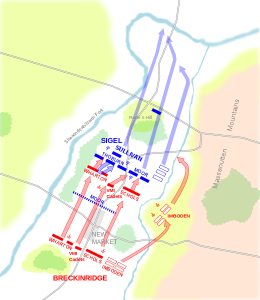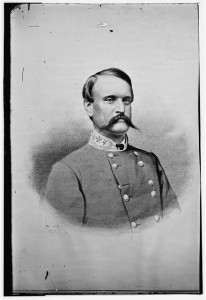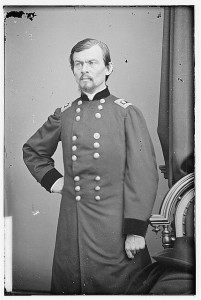SENECA and his fellow soldiers in the 1st New York Veteran Cavalry took part in the May 15, 1864 Union defeat at New Market.
From a Seneca County, New York newspaper in 1864:
From the Veteran Cavalry.
NUMBER V.
CAMP NEAR CEDAR CREEK, VA.,
May 21, 1864.
FRIEND STOWELL: – “A mail for home to-morrow” has just rung through the camp and as it is many a day since we have received or sent out a mail, all who are not on duty are busy writing to the dear ones at home.
Since my last there have been “Rows and Ructions at Lanagan’s Ball.” The Veterans have been travelling around through Western Virginia pretty extensively, and at last have met the enemy in a pitched battle. As many an anxious one at home have heard little or nothing from us during the past month, I will briefly recapitulate our doings during this period.
On the 18th of April, three hundred picked men from the 1st Veteran (among whom was thirty from Co. K) joined Gen. Averill’s command for a grand raid through Western Virginia. We proceeded as far as Clarksburg, about two hundred and fifty miles from Harpers Ferry and fifty miles from the Ohio. After remaining here a few days, we were ordered back by Gen. Sigel, while the rest of the expedition proceeded on its way and of its glorious results, how it has destroyed the Western Railroads, and defeated the enemy in three different battles, you have doubtless already heard.
On the 29th ult., the Army of the Shenandoah took the field and advancing up the Valley formed one of the connections between the Army of the Potomac and the Army of the West.
On Sunday, May 1st, one column entered the city of Winchester with bands playing and flags flying – encamping just outside the town for several days, we again advanced and on the 9th reached Cedar Creek, where Gen. Banks lost all his baggage and commissary stores, when Stonewall Jackson drove him down the Valley. Here news of the great conflict between Grant and Lee began to reach us and the camp was wild with all sorts of rumors and reports.
On the 11th, the Veterans advanced on Woodstock, which place was held by a body of Rebel Cavalry. We drove the “Johnnies” from the town and across the Shenandoah, and on the 13th inst., after a short engagement, again drove them from Mt. Jackson and captured the Barracks, &c. built by Stonewall.
Learning that Gen. John C. Breckinridge was coming down the Valley in force, Gen. Sigel hastened hastened his army forward to meet the enemy, who were said to be strongly posted at New Market, under Imboden and Gilmore. WE arrived near the town on Sunday morning, the 15th inst. Our columns were immediately deployed, the Artillery posted and soon commenced the
BATTLE OF NEW MARKET,
one of the sharpest engagements ever fought in this Valley, and one of the most unsatisfactory in its results. The plan (as far as I can understand it in dutch) was to fight and whip the rebel force at New Market before Gen. Breckinridge arrived, but he was already there with ten thousand Infantry, before the battle opened and we were thus confronted by a vastly superior force of the enemy. Our men fought bravely, desperately, put [but] it was of no avail. Owing to the small force of our Infantry, our Cavalry were placed in rather a novel position, and the Batteries were supported by us alone, that all the Infantry might be put in line of battle, but even then we were out flanked on both sides and nearly surrounded. Company K was divided and one half, under Capt. Brett, was placed on the extreme left of our lines in advance, and the rest of the company occupied a like position on the extreme right of the line of battle. These two position [sic] we held during the whole day without losing a man. Sergt. A.B. Randolph was the only one wounded, he being knocked from his horse by a piece of shell but is all right now.
The Rebels worked their Artillery with wonderful accuracy. Nearly every shell tore through the Cavalry Squadron or made wicked gaps in the Infantry line. – For a time our men fought well, but when the rebels advanced, in three magnificent lines of battle, upon us, our Infantry already much weakened by the severe canonade [sic], could stand no longer and broke and fled from the field in disorder, leaving the Cavalry to bring off the Artillery and cover the retreat. Our boys behaved splendidly and the 1st Veterans was the last regiment to leave the field and then only on a walk, although the shot and shell were pouring in from all sides.
After driving our forces back about four miles the rebels gave up the chase, but we fell back during the night twenty-two miles to Woodstock, destroying the bridges on the way, and next day continued our retreat twelve miles farther to Cedar Creek, where we took up a strong position, which we now hold, daily expecting an attack from the enemy.
There is no use denying the fact that we have been pretty severely thrashed, although we made the enemy pay pretty dearly for the chase he gave us, and we have brought off all our baggage and commissary stores, for which Gen. Sigel deserves much credit.
Upon the battle field there were of course some mistakes and some green performances; at one time it was almost impossible to tell who commanded the Cavalry. One officer would ride up and give an order which would be instantly countermanded by another. A certain Lieut. Col. whose namesake lived a good many years before the flood, made himself very officious. Once the regiment received orders to change its position, and had just began to execute the movement when up came Gen. Stahl [Julius Stahel] on a gallop screaming out “Where is mine Gabblery! Where he go! Who sent him dere? Stop, stop mine Gabblery!” Of course the “Gabblery” was stopped and a laugh rang through the ranks, mingling strangely with the screaming of shells, the whistling of bullets, and the groans of the wounded and dying.
The “Veterans” have received the thank [sic] of Gen. Sigel for the coolness and courage they displayed during this disastrous day, and the gallant conduct of our commanding officers will never be forgotten by their men. Our color bearer fell mortally wounded on the field and as he held our battle flag in his dying grasp, said: “Tell my mother I died by the old flag.” Several officers had their horses shot under them and many non-commissioned officers and private [sic] distinguished themselves on this bloody field, but it is wrong to particularize where all did so well, and none of our friends will ever blush for what was done at Mew Market, by the boys from
SENECA.
Shelby Foote alluded[1] to the language issue as he wrote about General Sigel being in his element during the battle. He kept his composure under fire, “but betrayed his inner excitement by snapping his fingers disdainfully at shellbursts as he rode about, barking orders at his staff. Unfortunately, he barked them in German, which resulted in some confusion…”
![[...] Kerr and Harvey Carter [...] of battery which fired first and last shots of Battle of New Market, 1864](https://www.bluegrayreview.com/wp-content/uploads/2014/05/43401r.jpg)
“[…] Kerr and Harvey Carter […] of battery which fired first and last shots of Battle of New Market, 1864” (1923)
- [1]Foote, Shelby. The Civil War, A Narrative. Vol. 3. Red River to Appomattox. New York: Random House, 1986. Print. page 249.↩



![Gen. Julius Stahel (Hungarian name [SZAMWALD?] (between 1860 and 1870; LOC: LC-DIG-cwpb-05219)](https://www.bluegrayreview.com/wp-content/uploads/2014/05/05219r-200x300.jpg)
